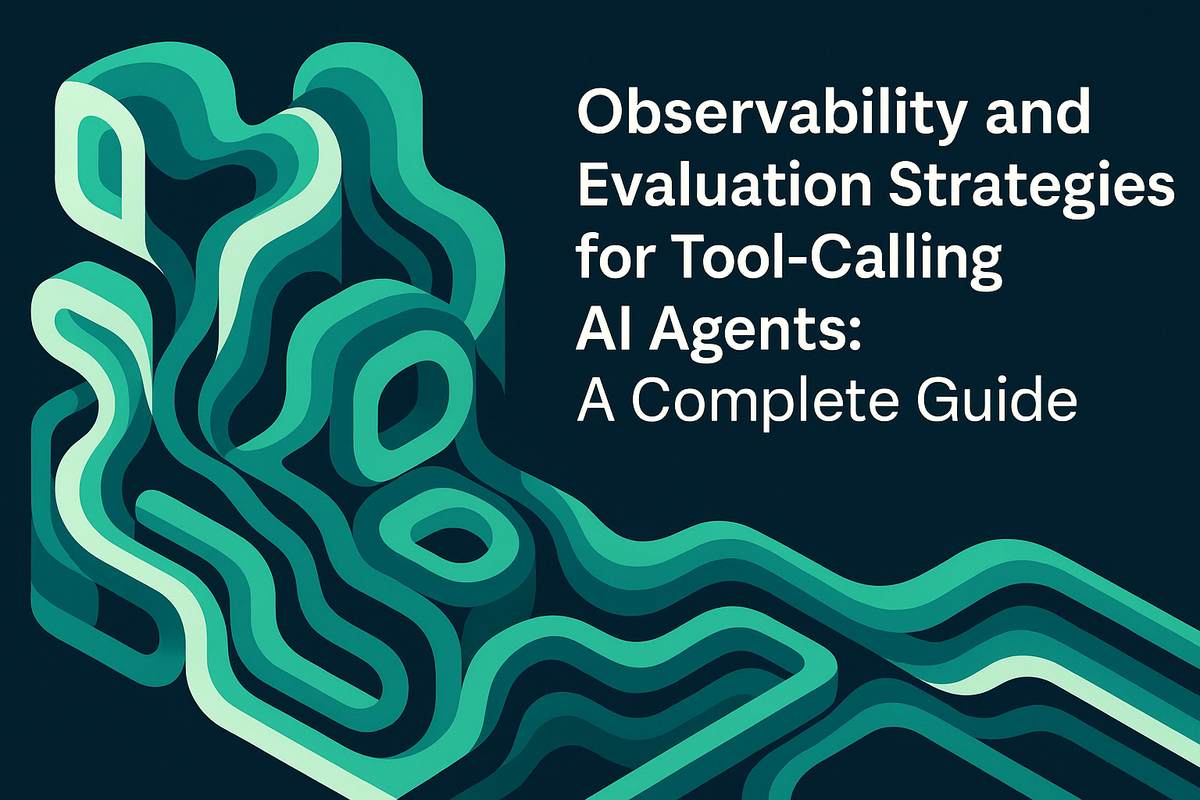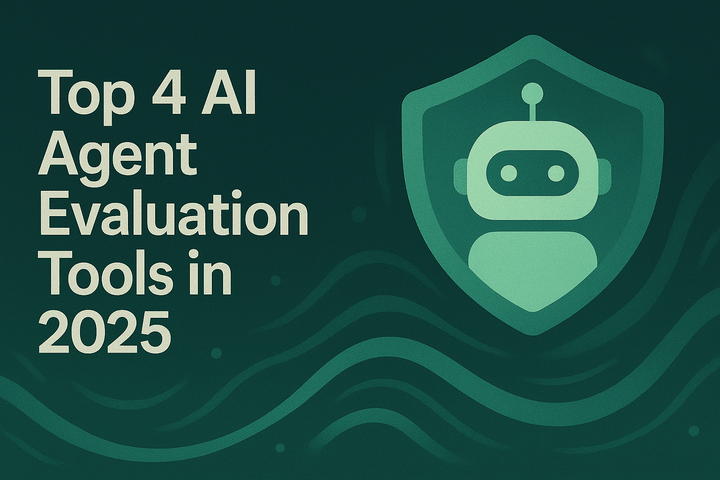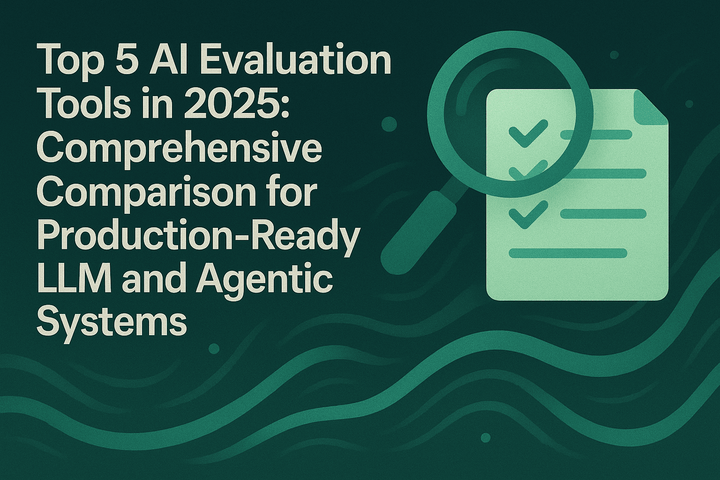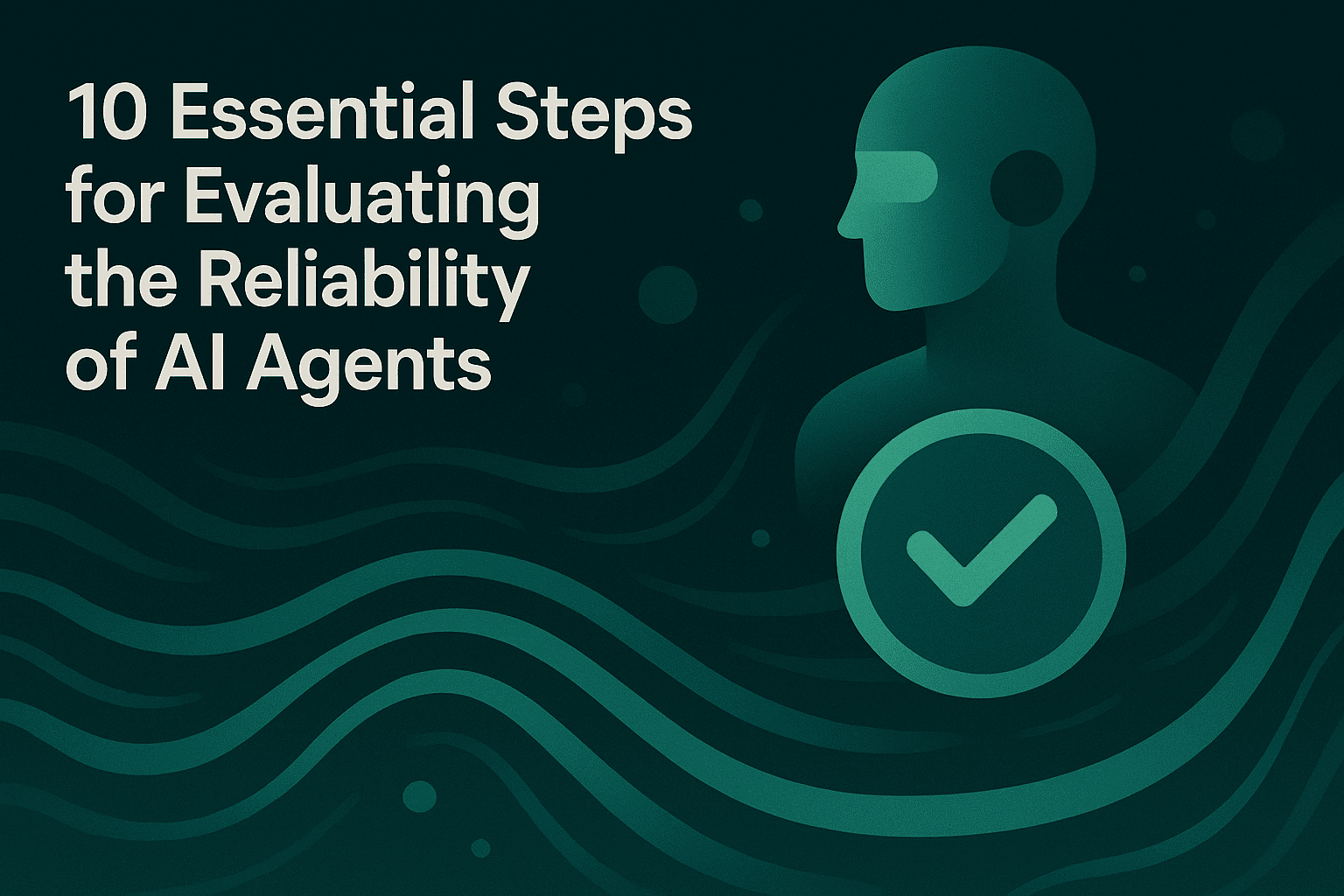Observability and Evaluation Strategies for Tool-Calling AI Agents: A Complete Guide

The proliferation of AI agents capable of executing actions through external tools has fundamentally transformed how enterprises build intelligent systems. These tool-calling agents, from customer support bots that access databases to autonomous assistants that manage calendars and send emails, represent a significant evolution beyond traditional conversational AI. However, this increased capability introduces substantial complexity in monitoring, debugging, and ensuring reliable performance.
As organizations scale their AI applications, the challenge isn’t just building agents that can call tools, it’s ensuring these agents call the right tools with the correct parameters at the appropriate times. This comprehensive guide explores the technical foundations of observing and evaluating tool-calling AI agents, providing engineering teams with actionable strategies for maintaining production quality.
Understanding Tool-Calling AI Agents
Tool-calling AI agents extend the capabilities of large language models by enabling them to interact with external systems and services. Unlike basic chatbots that only generate text responses, these agents can execute real-world actions: querying databases, calling APIs, retrieving documents from knowledge bases, or manipulating data in external systems.
A typical tool-calling agent operates through a structured workflow:
- Input Processing: The agent receives a user request and analyzes the intent
- Tool Selection: Based on the request, the agent determines which tools (if any) are needed
- Parameter Generation: The agent constructs appropriate parameters for the selected tools
- Tool Execution: External systems process the tool calls and return results
- Response Synthesis: The agent integrates tool outputs into a coherent response
Consider a customer service agent designed to handle order inquiries. When a user asks “What’s the status of my order #12345?”, the agent must:
- Recognize this requires external data retrieval
- Select the appropriate get_order_status tool
- Extract and format the order ID correctly
- Execute the API call
- Interpret the returned data
- Formulate a user-friendly response
This multi-step process introduces numerous potential failure points that require sophisticated observability and evaluation strategies.
The Critical Role of Agent Observability
Agent observability provides visibility into the internal workings of AI systems, enabling teams to understand behavior, diagnose issues, and optimize performance. For tool-calling agents, observability becomes exponentially more complex than for simple language models due to the distributed nature of agent operations.
Traditional application observability focuses on metrics like latency, error rates, and throughput. AI observability must additionally capture:
- Decision pathways: Understanding why an agent chose specific tools
- Tool execution accuracy: Verifying correct tool selection and parameter generation
- Multi-step reasoning: Tracking how agents decompose complex requests
- Error propagation: Identifying how failures cascade through agent workflows
Without comprehensive observability, teams operate blind, unable to distinguish between model hallucinations, incorrect tool selections, malformed parameters, or external system failures.
Implementing Distributed Tracing for AI Agents
Distributed tracing provides the foundational architecture for observing tool-calling agents. Tracing captures the complete execution path of a request as it flows through various components, creating a comprehensive audit trail of agent behavior.
Traces: The Complete Request Journey
A trace represents the entire lifecycle of a single user request through your AI system. For tool-calling agents, a trace typically encompasses:
- Initial user input processing
- Agent reasoning and planning steps
- Tool selection decisions
- Individual tool executions
- Response generation
Maxim’s Python SDK supports trace creation and input/output logging:
# Tracing: initialize SDK and create a trace
# Requires: pip install maxim-py
from maxim import Maxim
# Initialize using environment variables:
# - MAXIM_API_KEY
# - MAXIM_LOG_REPO_ID
maxim = Maxim()
logger = maxim.logger()
trace = logger.trace({
"id": "trace-id", # Unique ID of the trace
"name": "user-query"
})
trace.set_input("Hello, how are you?")
trace.set_output("I'm fine, thank you!")
trace.end()
This creates a top-level trace that will contain all subsequent operations for this request, providing a unified view of agent behavior.
Spans: Granular Operation Tracking
Within traces, spans represent individual operations or steps. For tool-calling agents, spans typically track:
- Reasoning spans: Agent planning and decision-making
- Tool call spans: Individual tool invocations
- Retrieval spans: Database or knowledge base queries
- Generation spans: LLM inference calls
Spans can be created from traces or via the logger, and nested to represent hierarchical relationships:
# Spans: create spans from a trace or logger
from maxim import Maxim
maxim = Maxim()
logger = maxim.logger()
# Create a trace object first
trace = logger.trace({"id": "trace-id", "name": "customer-support"})
# Option A: create span via trace object
span = trace.span({
"id": "span-id",
"name": "customer-support--classify-question"
})
# Option B: create span via logger (attach to an existing trace by ID)
span2 = logger.trace_add_span("trace-id", {
"id": "span-id-2",
"name": "customer-support--intent-detection"
})
This hierarchical structure enables teams to understand the complete sequence of operations and identify exactly where issues occur within complex agent workflows.
Generations: LLM Interaction Tracking
Generations represent specific LLM inference calls within your agent system. These capture critical details about model interactions:
- Input prompts and system instructions
- Model configuration (temperature, max tokens, etc.)
- Output completions
- Token usage and costs
- Latency metrics
# Generations: log an LLM call and its result/usage
from time import time
from maxim import Maxim
maxim = Maxim()
logger = maxim.logger()
trace = logger.trace({"id": "trace-id", "name": "support-intake"})
# Create a generation on the trace (use span.generation when inside a span)
generation = trace.generation({
"id": "generation-id",
"name": "customer-support--gather-information",
"provider": "openai",
"model": "gpt-4o",
"messages": [
{"role": "system", "content": "You are a helpful assistant who helps gather customer information."},
{"role": "user", "content": "My internet is not working"}
],
"model_parameters": {"temperature": 0.7}
})
# When you receive the model response, attach the result
generation.result({
"id": "chatcmpl-123",
"object": "chat.completion",
"created": int(time()),
"model": "gpt-4o",
"choices": [{
"index": 0,
"message": {
"role": "assistant",
"content": "Apologies for the inconvenience. Can you please share your customer id?"
},
"finish_reason": "stop"
}],
"usage": {
"prompt_tokens": 100,
"completion_tokens": 50,
"total_tokens": 150
}
})
Tracking generations separately enables teams to analyze model performance, optimize costs, and identify patterns in how agents interact with underlying LLMs.
Sessions: Multi-Turn Conversation Context
Sessions group related traces together, representing extended user interactions. For conversational agents, sessions capture the complete dialogue history, enabling analysis of:
- Multi-turn conversation quality
- Context maintenance across interactions
- User satisfaction throughout extended engagements
- Session-level metrics like resolution rate and conversation length
# Sessions: group related traces into a single conversation/workflow
from maxim import Maxim
maxim = Maxim()
logger = maxim.logger()
# Create a session
session = logger.session({
"id": "session-id",
"name": "customer-support-session"
})
# Add a trace to the session via session.trace
trace1 = session.trace({"id": "trace-id-1", "name": "initial-inquiry"})
trace1.set_input("What's the status of order 12345?")
trace1.set_output("Let me check that for you.")
trace1.end()
# Link a trace to the same session using session_id via logger.trace
trace2 = logger.trace({
"id": "trace-id-2",
"name": "follow-up",
"session_id": "session-id"
})
trace2.set_input("Can you also cancel it?")
trace2.set_output("I can help with that.")
trace2.end()
Session-level observability enables teams to evaluate agent performance holistically rather than examining isolated interactions.
Capturing Tool Call Execution
Tool call tracing requires specialized instrumentation to capture the complete lifecycle of external function executions. Proper tool call observability should capture:
- Tool identification: Which specific tool was invoked
- Input parameters: Arguments passed to the tool
- Execution results: Data returned from the tool
- Error conditions: Failures or exceptions during execution
- Execution metadata: Latency, status codes, and other operational metrics
Maxim provides structured logging for tool calls:
# Tool Calls: record tool call details and log results or errors
from maxim import Maxim
from maxim.logger import ToolCallError
maxim = Maxim()
logger = maxim.logger()
trace = logger.trace({"id": "trace-id", "name": "tool-call-demo"})
# Suppose you have a tool call from an LLM response (OpenAI-style)
# tool_call = completion.choices[0].message.tool_calls[0]
# Example stub tool call object
class ToolCallLike:
def __init__(self):
self.id = "call_abc123"
class Fn: pass
self.function = Fn()
self.function.name = "get_current_temperature"
self.function.arguments = {"location": "New York"}
tool_call = ToolCallLike()
# Create and log the tool call on the trace (use span.tool_call inside a span)
trace_tool_call = trace.tool_call({
"id": tool_call.id,
"name": tool_call.function.name,
"description": "Get current temperature for a given location.",
"args": tool_call.function.arguments,
"tags": {"location": tool_call.function.arguments["location"]}
})
def call_external_service(name: str, args: dict):
# Replace with your actual integration
if name == "get_current_temperature":
return {"location": args["location"], "temperature_c": 22.5}
raise ValueError(f"Unknown tool: {name}")
try:
result = call_external_service(tool_call.function.name, tool_call.function.arguments)
trace_tool_call.result(result)
except Exception as e:
error = ToolCallError(message=str(e), type=type(e).__name__)
trace_tool_call.error(error)
This structured approach ensures complete visibility into tool execution, enabling precise debugging when tools fail or produce unexpected results.
Example: Building an Observable E-commerce Agent
To illustrate these concepts, consider a practical implementation of an e-commerce support agent with comprehensive observability:
from maxim import Maxim
maxim = Maxim()
logger = maxim.logger()
import json
class EcommerceAgent:
def __init__(self, repo_id=None):
# Using environment variables (MAXIM_API_KEY, MAXIM_LOG_REPO_ID) by default
self.logger = logger
self.tools = {
"get_order_status": self.get_order_status,
"cancel_order": self.cancel_order,
"track_shipment": self.track_shipment
}
def handle_request(self, user_message, user_id, session_id):
# Create session if new conversation
session = self.logger.session({
"id": session_id,
"name": "ecommerce-support"
})
# Create trace for this request
trace = session.trace({"id": f"trace-{user_id}", "name": "process-user-request"})
trace.set_metadata({"user_message": user_message})
# Agent reasoning step (span)
planning_span = trace.span({"id": "span-planning", "name": "agent-planning"})
intent = self.analyze_intent(user_message)
planning_span.set_attribute("detected_intent", intent)
required_tools = self.select_tools(intent, user_message)
planning_span.set_attribute("selected_tools", required_tools)
# Tool execution step (spans)
tool_results = []
for tool_spec in required_tools:
tool_span = trace.span({"id": f"span-exec-{tool_spec['name']}", "name": f"execute-{tool_spec['name']}"})
tool_span.set_attribute("tool_name", tool_spec["name"])
tool_span.set_attribute("tool_arguments", tool_spec["arguments"])
# Log tool call
trace_tool_call = tool_span.tool_call({
"id": f"call-{tool_spec['name']}",
"name": tool_spec["name"],
"description": f"Execute tool {tool_spec['name']}",
"args": tool_spec["arguments"],
"tags": {"intent": intent}
})
try:
result = self.tools[tool_spec["name"]](**tool_spec["arguments"])
tool_span.set_attribute("execution_status", "success")
tool_span.set_attribute("tool_result", result)
trace_tool_call.result(result)
tool_results.append(result)
except Exception as e:
tool_span.set_attribute("execution_status", "failed")
tool_span.set_attribute("error_message", str(e))
from maxim.logger import ToolCallError
trace_tool_call.error(ToolCallError(message=str(e), type=type(e).__name__))
raise
# Response generation (generation)
generation = trace.generation({
"id": "generation-response",
"name": "generate-response",
"provider": "openai",
"model": "gpt-4o",
"messages": [
{"role": "system", "content": "You are a helpful ecommerce assistant."},
{"role": "user", "content": user_message}
],
"model_parameters": {"temperature": 0.3}
})
response = self.generate_response(user_message, tool_results)
generation.result({
"id": "chatcmpl-response",
"object": "chat.completion",
"created": int(__import__('time').time()),
"model": "gpt-4o",
"choices": [{
"index": 0,
"message": {"role": "assistant", "content": response},
"finish_reason": "stop"
}],
"usage": {"prompt_tokens": 0, "completion_tokens": 0, "total_tokens": 0}
})
trace.set_output(response)
trace.end()
return response
def analyze_intent(self, text: str):
text_l = text.lower()
if "status" in text_l or "order" in text_l:
return "order_status"
if "cancel" in text_l:
return "cancel_order"
if "track" in text_l or "shipment" in text_l:
return "track_shipment"
return "general"
def select_tools(self, intent: str, text: str):
if intent == "order_status":
order_id = "".join([c for c in text if c.isdigit()]) or "unknown"
return [{"name": "get_order_status", "arguments": {"order_id": order_id}}]
if intent == "cancel_order":
order_id = "".join([c for c in text if c.isdigit()]) or "unknown"
return [{"name": "cancel_order", "arguments": {"order_id": order_id}}]
if intent == "track_shipment":
tracking_number = "".join([c for c in text if c.isalnum()]) or "unknown"
return [{"name": "track_shipment", "arguments": {"tracking_number": tracking_number}}]
return []
def generate_response(self, user_message, tool_results):
if not tool_results:
return "I’ve captured your request. Could you share your order ID so I can help further?"
# Simple synthesis for demo purposes
return json.dumps({"user_message": user_message, "results": tool_results})
# Simulated tools
def get_order_status(self, order_id):
return {"order_id": order_id, "status": "shipped", "eta": "2025-10-06"}
def cancel_order(self, order_id):
return {"order_id": order_id, "cancellation_status": "confirmed"}
def track_shipment(self, tracking_number):
return {"tracking_number": tracking_number, "location": "Distribution center"}
This implementation demonstrates how comprehensive observability integrates naturally into agent workflows, capturing every decision point and execution step without compromising performance.
Evaluating Tool Call Accuracy
Observability provides visibility into agent behavior, but evaluation determines whether that behavior is correct. Tool call accuracy evaluation assesses whether agents select appropriate tools and generate correct parameters.
Understanding Tool Call Accuracy Metrics
Tool call accuracy operates at multiple levels:
- Tool Selection Accuracy: Did the agent choose the correct tool(s)?
- Parameter Accuracy: Were the tool parameters correctly extracted and formatted?
- Execution Success: Did the tool call execute without errors?
- Result Relevance: Did the tool output address the user’s actual need?
An automated evaluator can compare actual tool calls against expected ground truth:
# Tool Call Accuracy: compute evaluation score for function-calling
from maxim_py.evaluators import ToolCallAccuracy
evaluator = ToolCallAccuracy()
expected_output = [
{"name": "get_order_status", "arguments": {"order_id": "12345"}}
]
actual_output = [
{"name": "get_order_status", "arguments": {"order_id": "12345", "include_history": False}}
]
result = evaluator.evaluate(
expected=expected_output,
actual=actual_output
)
# Result contains a float score (0..1) and optional reasoning text
print("Score:", result.Result)
print("Reasoning:", getattr(result, "Reasoning", None))
Higher scores indicate that most expected tool calls were made correctly with proper parameters and order. Lower scores signal mismatches in tools, arguments, or sequence.
Building Comprehensive Evaluation Datasets
Effective tool call evaluation requires high-quality test datasets that represent real-world usage patterns. Teams should curate datasets that include:
- Common scenarios: Typical user requests that should trigger standard tool calls
- Edge cases: Unusual requests that test agent reasoning boundaries
- Ambiguous inputs: Queries that could validly trigger multiple tools
- Error conditions: Invalid requests that should not trigger any tools
- Multi-tool scenarios: Complex requests requiring multiple sequential or parallel tool calls
evaluation_dataset = [
{
"user_input": "What's the status of order 12345?",
"expected_tools": [
{"name": "get_order_status", "arguments": {"order_id": "12345"}}
]
},
{
"user_input": "Cancel my order and refund my payment",
"expected_tools": [
{"name": "cancel_order", "arguments": {"order_id": "{{order_id}}"}},
{"name": "process_refund", "arguments": {"order_id": "{{order_id}}"}}
]
},
{
"user_input": "What's your return policy?",
"expected_tools": [] # Should not trigger tools, just provide information
}
]
Continuous Evaluation in Production
While pre-deployment evaluation validates agent capabilities, continuous evaluation in production ensures sustained quality. Production strategies include:
- Sampling-based evaluation: Randomly select production traces for automated evaluation
- Human-in-the-loop review: Route uncertain cases to human reviewers for labeling
- Anomaly detection: Identify unusual tool call patterns that may indicate issues
- A/B testing: Compare tool call accuracy across different agent versions
Debugging Tool-Calling Agents
Comprehensive observability and evaluation enable systematic debugging of agent issues. Common failure modes in tool-calling agents include:
Tool Selection Errors
Symptom: Agent calls incorrect tools or fails to call necessary tools.
Debugging approach:
- Examine the agent’s reasoning spans to understand decision-making
- Review the input prompt and system instructions
- Analyze tool descriptions for clarity and completeness
- Check for ambiguous tool names or overlapping functionality
Parameter Generation Errors
Symptom: Correct tool selected but with malformed or incorrect parameters.
Debugging approach:
- Inspect the tool call spans for parameter values
- Validate parameter extraction from user input
- Review tool schemas for clarity and required fields
- Check for edge cases in parameter formatting (dates, numbers, etc.)
Cascading Failures
Symptom: Initial tool failure causes subsequent errors.
Debugging approach:
- Trace the complete span hierarchy to identify the initial failure point
- Examine error propagation through parent-child span relationships
- Assess error handling and fallback mechanisms
- Implement circuit breakers for known failure scenarios
Best Practices for Production AI Agent Quality
Maintaining high-quality tool-calling agents in production requires systematic approaches to observability and evaluation:
- Instrument Comprehensively from Day OneImplement tracing and logging before deploying agents to production. Retrofitting observability into existing systems is significantly more challenging than building it from the start.
- Establish Baseline MetricsBefore deploying new features or model updates, establish baseline performance metrics:
- Tool call accuracy rates
- Task completion percentages
- Average latency per tool type
- Error rates by tool and failure mode
- Implement Progressive RolloutsDeploy agent changes gradually using canary deployments or A/B testing, with continuous monitoring of quality metrics to detect regressions early.
- Curate Production Data for Continuous ImprovementSystematically collect production data to expand evaluation datasets:
- Edge cases that weren’t anticipated
- User interactions that revealed agent weaknesses
- Successful conversation patterns to reinforce
- Integrate Human Feedback LoopsCombine automated evaluation with human review:
- Route low-confidence predictions to human reviewers
- Collect explicit user feedback on agent responses
- Conduct periodic quality audits by domain experts
- Monitor Drift and DegradationAgent performance can degrade over time due to changes in user behavior, updates to external tool APIs, or shifts in underlying model capabilities. Implement automated alerts for statistical anomalies in key metrics to detect degradation early.
The Future of AI Agent Observability
As AI agents become more autonomous and complex, observability and evaluation frameworks must evolve to match. Emerging trends include:
- Multi-agent observability: Tracking interactions between specialized agents collaborating on complex tasks
- Causal analysis: Understanding not just what agents do, but why they make specific decisions
- Predictive quality metrics: Proactively identifying potential failures before they impact users
- Automated remediation: Self-healing agents that detect and correct their own errors
Organizations investing in robust observability infrastructure today position themselves to leverage these advanced capabilities as they mature.
Conclusion
Observability and evaluation represent foundational pillars for building reliable tool-calling AI agents. By implementing comprehensive distributed tracing, teams gain unprecedented visibility into agent decision-making processes. Systematic evaluation frameworks enable quantitative assessment of agent quality and identification of improvement opportunities.
The combination of real-time observability and rigorous evaluation creates a virtuous cycle: observability data informs evaluation datasets, evaluation results guide improvements, and enhanced agents generate better observability insights. Organizations that master this cycle will deliver AI agents that consistently meet user expectations and business objectives.
Maxim AI provides an end-to-end platform for AI agent simulation, evaluation, and observability, enabling teams to ship reliable AI applications faster. From experimentation and evaluation to production monitoring and debugging, Maxim empowers engineering and product teams to maintain the highest quality standards throughout the AI development lifecycle.
Ready to elevate your AI agent quality? Get started with Maxim or schedule a demo to see how our platform can transform your agent observability and evaluation workflows.


